|
Spitfire Mk.IX
‘The Longest Day’
Limited Edition
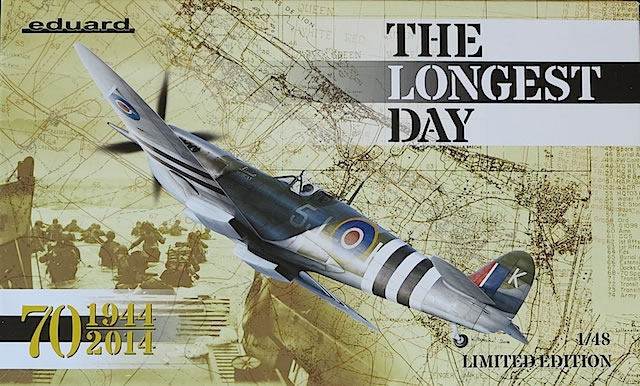
Eduard, 1/48 scale
S
u m m a r y |
| Catalogue Number: |
Eduard Kit No. 1191 – Spitfire Mk.IX ‘The Longest Day’ Limited Edition |
| Scale: |
1/48 |
| Contents and Media: |
Approximately 197 grey plastic parts (26 unused); 14 clear plastic parts (3 unused); one decal sheet containing markings for five aircraft; one decal sheet containing airframe stencils for one aircraft; six grey resin parts; one sheet of pre-cut canopy masks; one fret of pre-painted photo-etched parts; 16 page instruction booklet with full colour painting and marking guide. |
| Price: |
USD$50.96 online from Eduard’s website, but currently out of stock also available from specialist hobby retailers worldwide. |
| Review Type: |
FirstLook |
| Advantages: |
Accurate and well-engineered kit; high quality plastic, resin and photo-etched parts with excellent detail; interesting, themed marking options; good instructions and decals. |
| Disadvantages: |
None noted. |
| Conclusion: |
If you like your Spitfires with stripes, then this is the kit for you: Eduard’s matching of its excellent 1/48 Mk.IX sprues with five interesting D-Day schemes makes for an attractive package. The bad news is that the kit quickly sold out on Eduard’s web store; I suspect it can be found elsewhere if you look, but I’d recommend starting now because as a Limited Edition release it may not be offered again. Highly recommended. |
Reviewed by Brad Fallen

Eduard's 1/48 scale Spitfire Mk.IXe Weekend Edition
is available online from Squadron.com for just $26.96!
In his excellent book ‘Spitfire in Combat’ Alfred Price estimates that Spitfire deployment stood at its greatest extent in early June 1944, when over 120 Allied squadrons operated the fighter. Nearly half were flying the Mk.IX, which had been thrown into service against the Focke Wulf Fw 190 two years earlier and subsequently refined into arguably the definitive Merlin-powered Spitfire. The concentration of Mk.IXs was even greater in the RAF’s Second Tactical Air Force, which used nearly 30 squadrons of the type to support the invasion of France. Second TAF squadrons were soon operating from captured or improvised airfields close behind the front line, where range wasn’t an issue and the Mk.IXs were thrown into battle as fighter-bombers. In common with almost all other Allied aircraft involved with D-Day these Spitfires wore black-and-white identification stripes, in a variety of interpretations and sometimes for months after the invasion.
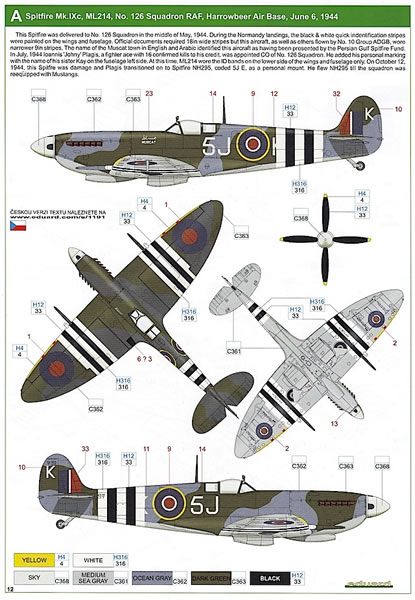
Eduard released this Limited Edition 1/48 Spitfire Mk.IX in June this year to coincide with the 70th anniversary of Operation Overlord. The same sprues have been released in a number of boxings since the first Mk.IXc kit came out in April 2013, including the following kits reviewed here on Hyperscale:
These reviews have thoroughly addressed the numerous strengths and few weaknesses of Eduard’s 1/48 Spitfire mouldings, and it’s not my intention to cover these again here. I’ll focus instead on what’s different and special about this anniversary release, particularly the marking choices.
The kit’s D-Day theme is reflected in the box art with its image of Spitfire Mk.IXc ML214/5J-K (marking option A) overlaid on a map of the landing beaches and a photo of soldiers wading ashore.
Inside the box are the following items:
- Five sprues of grey plastic parts, including wing sprues for Mk.IXc (late) and Mk.IXe variants. The parts are all well moulded with no imperfections, and at the end of your build you will have over 25 unused parts for your spares box. For images of these parts, please refer to the linked reviews above.
- One clear plastic sprue containing parts for the canopy, gun sight and airframe lights. The clipped wing tips aren’t required for this build and so are further welcome spares.
- A small sheet of pre-cut tape canopy masks, which I always find indispensable.
- A fret of photo-etched brass containing both painted and unpainted parts. The latter includes items such as the seat armour plating and oleo scissors, which you are better off painting yourself than trying to colour match. The pre-painted parts, particularly the instrument panel and seat harnesses, offer much finer colour detail than I could achieve with a brush.
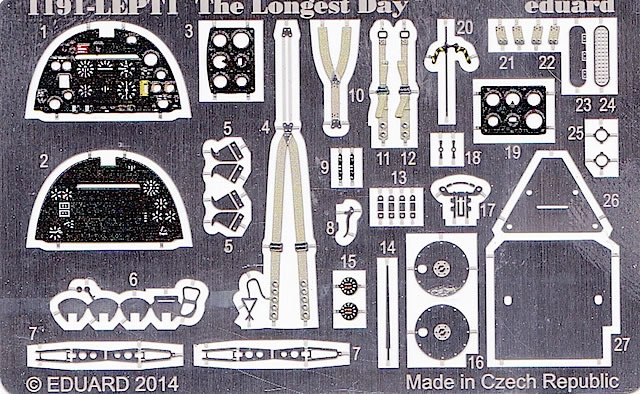
- Resin (Brassin) parts for one 500 lb bomb and its attachment points. (The kit sprues have parts for two 250 lb bombs, but not a 500 pounder.) The parts are cleanly cast and should be easy to tidy up and assemble. Rings and stencils for the bomb are provided as decals, with placement and painting instructions included in the kit stencil placement guide.
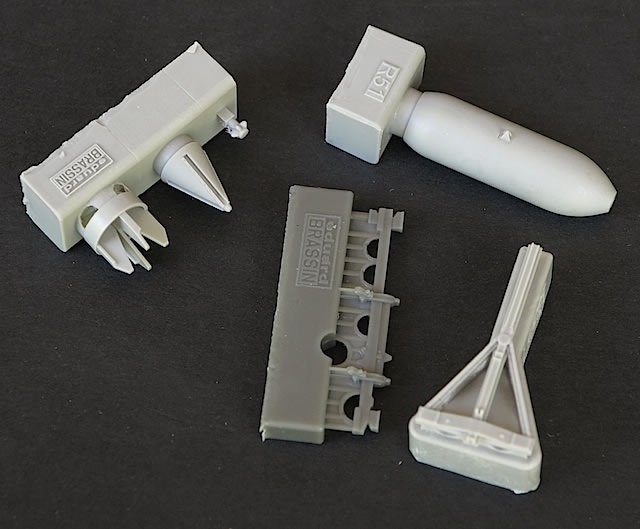
- Two decal sheets – the larger one printed by Cartograf and containing national insignia, codes, serials and individual markings, as well as an instrument panel decal as an alternative to the photo-etched parts. The quality of the decals is what you would expect from this manufacturer – crisp registration, accurate colours and good colour density. The smaller sheet of stencils has been printed by Eduard and, while slightly less glossy and sharply defined than the Cartograf decals, will still produce good results if applied on a nice glossy surface.
- A 16-page A4 instruction booklet, which includes a clearly illustrated step-by-step assembly guide, full colour four view drawings of each marking option (apart from option E – see below), and a four-view greyscale stencil placement guide. Curiously, the aircraft depicted in the guide is a clipped wing, pointed rudder-equipped Mk.IXe, which doesn’t reflect any of the kit marking options – although this doesn’t matter in terms of stencil placement.
Marking Options
This kit is all about the marking schemes: five RAF Spitfire Mk.IXs from June and July 1944, all wearing full invasion stripes over their Ocean Grey/Dark Green/Medium Sea Grey camouflage.
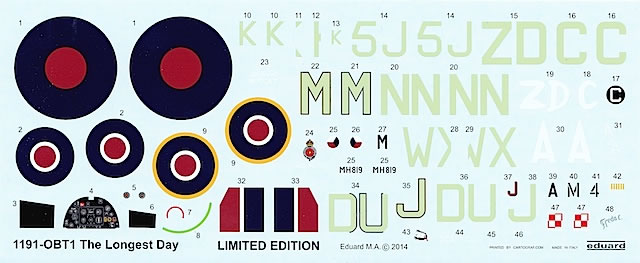
At face value this should mean five similar-looking Spitfires, but this is not the case as Eduard has chosen its subjects carefully:
- Spitfire Mk.IXc, ML214/5J-K, of No.126 Squadron, RAF Harrowbeer, Plymouth, 6 June 1944; later flown by Flight Lieutenant Ioannis ‘John’ Plagis, CO of No.126 Squadron. A presentation aircraft from the Persian Gulf Spitfire Fund, ML214 carried the name ‘Muscat’ in Arabic and English on the port cowling forward of the cockpit, along with nine inch wide invasion stripes (half the officially prescribed width). As a 126 Squadron machine this Spitfire was attached to the Air Defence of Great Britain, while the remainder of the marking options belonged to the Second TAF.
- Spitfire Mk.IXc, MK942/WX-A, flown by Flight Sergeant Michael Murayda of No.302 Squadron, RAF Chailey, Sussex, June 1944. Standing out on MK942’s standard-width stripes was the code letter ‘A’, which like the rest of the codes was originally Sky but – after being overpainted when the stripes were applied – was re-painted in white on the black fuselage stripes. This letter was also chalked on to the centre of the port fuselage roundel.
- Spitfire Mk.IXc, MK892/ZD-C, flown by Flight Lieutenant C. H. Lazenby of No.222 Squadron, RAF Selsey, Sussex, June 1944. As with the previous aircraft, MK892’s fuselage codes were partially overpainted by invasion stripes, with the obscured letters roughly reapplied beneath the canopy on each side. Flight Lieutenant Lazenby crash-landed MK892 in Normandy on 10 June 1944, and was taken prisoner.
- Spitfire Mk.IXe, PL124/DU-J, of No.312 Squadron, RAF Appeldram, Sussex, June 1944. DU-J’s most distinguishing feature was its incomplete fuselage invasion bands: the white stripes were painted but the black ones were not. There was also a narrow coloured, probably blue, band at the tip of the rudder.
- Spitfire Mk.IXc, MH819/NN-M of No.310 Squadron, RAF Appeldram, Sussex, June 1944. MH819 is probably the most conventionally marked of all the schemes on offer here, with its regulation-width stripes carefully painted around the fuselage codes. It’s also effectively a ‘bonus’ scheme, being represented by a port profile on the first page of the instruction sheet, compared to the four-view drawings and full descriptions of the other aircraft. Don’t fear if you wish to model MH819, however, as Eduard provides a link to similar information on its web site. http://www.eduard.com/store/out/media/1191.pdf)
If you like your Spitfires with stripes, then ‘The Longest Day’ is the kit for you: Eduard’s matching of its excellent 1/48 Mk.IX sprues with five interesting D-Day schemes and the usual Profipack extras makes for an attractive package. The bad news is that the kit quickly sold out on Eduard’s web store; I suspect it can be found elsewhere if you search, but I’d recommend starting now because as a Limited Edition release it may not be offered again.
Highly recommended.
References:
- Alfred Price, ‘Spitfire in Combat’ (Sutton, 2003).
Thanks to Eduard for the sample
Review Text and Images Copyright © 2014 by Brad Fallen
Page Created 28 November, 2014
Last updated
28 November, 2014
Back to HyperScale Main Page
Back to Reviews Page |
